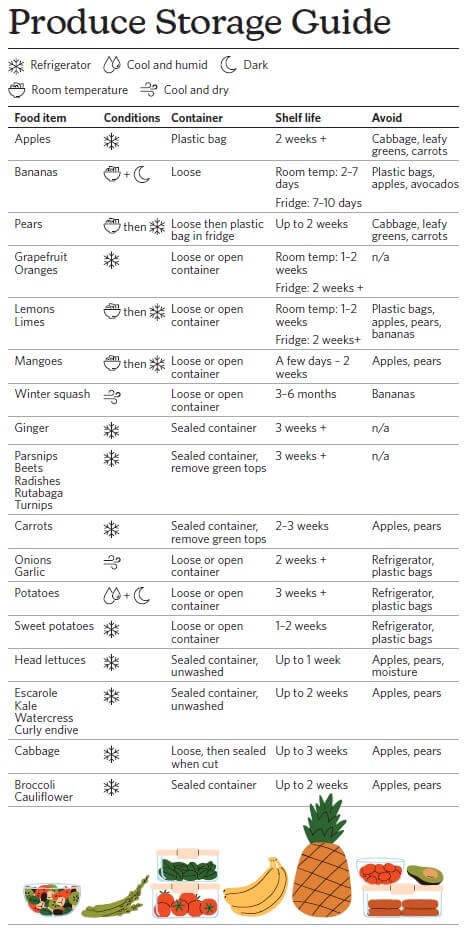The science behind the best ways to store fruits and vegetables
What a feeling of joy to unpack those cloth grocery bags filled with beautiful, farm-fresh raspberries and apples, asparagus and lettuce mix. You imagine your lunch salads for the week, the kids’ school snacks, that great guacamole you’re going to bring to that thing Thursday night. And then your mind turns and wonders: Will it still be fresh? The other side of enjoying organic produce picked in season is that it doesn’t last forever (and that’s a good thing). To help save money and avoid food waste, though, what are the best ways to store fruits and veggies so they last as long as possible?
Turns out, there’s a whole science to it—not just where to store fruits and veggies, but also which fruits and veggies can be stored together and which should be separated to help keep one from spoiling another (bananas, we’ve got our eyes on you). And then there’s the washing. Fortunately, the best practices only take a few extra minutes that make all the difference—and we’ve got a handy chart.
To Chill or Not to Chill
To help ensure your avocados, for example, don’t ripen and rot before you need them, it’s important to know which of the three storage steps are best for each fruit and veg: at room temperature on the counter, in the fridge once they’re ripe, or in the fridge as soon as you come home from your shop.
Have you been keeping green beans and cucumbers in the crisper? (Yes, us too). Well, these vegetables are among those that do best at room temp. At lower temperatures, produce in this group is susceptible to chilling injury. Eggplant and bell peppers, for example, should never be in a cooler with ice.
The extra perks of keeping oranges or bananas in a bowl on the table? They double as pleasant table decor. Plus, when they’re handy, a little hand might just pick one up and eat it!
The same applies to sliced berries and carrots for grab-and-go snacks: if they’re ready to eat, the kids might just go for it. Most sliced fruits can last about five days in the fridge and some veggies can last even longer. The trick with cut produce is to refrigerate and use airtight containers. Fruits that ripen quickly will brown once sliced, so when it comes to avocados, for example, store them whole instead.
To Pair or Not to Pair
Check out the chart to see which fruits and veggies belong in the fridge or on the counter. But, which ones should be separated from the bunch so they don’t overripen others? Well, there are two kinds of fruits: the ones that emit a lot of ethylene gas, which can speed up the ripening process, and the ones that don’t. Bananas, apples, avocados, stone fruits and tomatoes are some of the worst offenders, so keep them clear from grapes and blueberries, for example.
Another pro produce storage tip is to always keep onions alone. Mostly, it’s because they have a sharp smell that other foods can absorb. For some reason, potatoes really don’t like them and tend to wilt and sprout more quickly when onions are nearby.
What and When to Wash
Giving your lettuce and berries a quick shower before slicing and plating up is always a good idea. Even peeled fruits should have a rinse to avoid the remote chance of bacteria on the cutting board hitchhiking to your dessert bowl. Plus, as much as we all love knowing that romaine is garden fresh, most of us don’t really want to feel that garden dirt crunch with every bite.
Ideally, leafy greens would get a good five-minute soak in cold water, separating the leaves from the head and then spinning to dry in a spinner. Moisture, with lettuce and most produce, is enemy uno, so drying is key. Herbs should get the same treatment as leafy greens (pro tip, cut the ends like you would a flower bouquet and keep them in your fridge in a jar of water). Berries do best with a light strainer rinse right before eating.
Just before eating is the best time to give your fruits and veg a wash, but of course pre-prepped salads are a part of summer and as long as the lettuce leaves and berries are dried before slicing and refrigerating for a few hours, they’ll be fresh, delicious and ready to impress.

